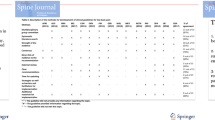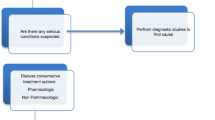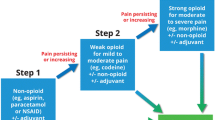Abstract
Objective
To prove specific effects of acupuncture on chronic pain. It was speculated that the potential specific effectiveness of acupuncture could be better shown in more properly designed studies. Therefore, diagnoses of both Western medicine and traditional Chinese medicine (TCM) were used as inclusion criteria to allocate acupoints more precisely to the complaints of the patients. Secondly, objectively measurable parameters of pain relief in addition to usual Visual Analogue Scale (VAS) were chosen to quantify the effects of acupuncture.
Methods
The study was prospective, randomized, controlled and single-blinded. Eighteen patients with chronic back pain and TCM diagnosis of a Taiyang/Yangming syndrome received one single session of acupuncture chosen according to TCM diagnosis or acupuncture on points outside the meridian system (controls). We evaluated pain via VAS and increased mobility via inclinometry of the back.
Results
Although the sample size was small, there was a statistically significant improvement in pain and mobility in the intervention group (n=13), but not in the control group (n=5). The calculated sample size adequate power was lower for inclinometry than for VAS, indicating that VAS is less probable to discriminate acupuncture effects.
Conclusion
Objectively measurable physical parameters such as the angle of flexion before and after acupuncture (inclinometry) may be more suitable to measure pain relief than subjective assessment by VAS in acupuncture studies. TCM diagnosis may be a helpful inclusion criterion in studies on acupuncture, so as to potentially allocate interventions better to the complaints of patients.
Similar content being viewed by others
References
Turk DC, Okifuji A. Pain Terms and Taxonomies//Loeser D, Butler SH, Chapman JJ. Bonica’s Management of Pain. 3rd Edition. Philadelphia: Lippincott Williams & Wilkins, 2001: 18–25.
Urquhart DM, Hoving JL, Assendelft WW, Roland M, van Tulder MW. Antidepressants for non-specific low back pain. Cochrane Database Syst Rev, 2008, (1): CD001703.
Henschke N, Maher CG, Refshauge KM, Herbert RD, Cumming RG, Bleasel J, York J, Das A, McAuley JH. Prognosis in patients with recent onset low back pain in Australian primary care: inception cohort study. BMJ, 2008, 337: a171.
Deyo RA, Mirza SK, Martin BI. Back pain prevalence and visit rates: estimates from U.S. national surveys, 2002. Spine (Phila Pa 1976), 2006, 31(23): 2724–2727.
Furlan AD, van Tulder MW, Cherkin DC, Tsukayama H, Lao L, Koes BW, Berman BM. Acupuncture and dry-needling for low back pain. Cochrane Database Syst Rev, 2005, (1): CD001351.
Hopton A, MacPherson H. Acupuncture for chronic pain: is acupuncture more than an effective placebo? A systematic review of pooled data from meta-analyses. Pain Pract, 2010, 10(2): 94–102.
Haake M, Müller HH, Schade-Brittinger C, Basler HD, Schäfer H, Maier C, Endres HG, Trampisch HJ, Molsberger A. German acupuncture trials (GERAC) for chronic low back pain: randomized, multicenter, blinded, parallel-group trial with 3 groups. Arch Intern Med, 2007, 167(17): 1892–1898.
Molsberger AF, Streitberger K, Kraemer J, Brittinger CS, Witte S, Boewing G, Haake M. Designing an acupuncture study: II. The nationwide, randomized, controlled German acupuncture trials on low-back pain and gonarthrosis. J Altern Complement Med, 2006, 12(8): 733–742.
Greten HJ. Textbook for Traditional Chinese Medicine. Stuttgart: Georg Thieme, 2003.
Greten HJ. Chinese Medicine as a Model of System Biology: Diagnosis as the Foundation of Acupoint Selection//Xia Y, Ding GH, Wu GC. Current Research in Acupuncture (Research Monograph), Springer: 2012.
Greten HJ. Chinese medicine as vegetative system biology. HNO, 2011, 59(12): 1160.
Greten H.J. Understanding TCM-scientific Chinese Medicine: The Heidelberg Model. Heidelberg: Heidelberg School Edition (course version), 2008.
Greten H.J. What is the role of Chinese medical theory in modern scientific research? J Acupunct Tuina Sci, 2008, 6(5): 259–260.
Greten H.J. Textbook for Traditional Chinese Medicine: Applying and Understanding TCM Properly. Stuttgart: Thieme, 2007.
Vickers AJ, Cronin AM, Maschino AC, Lewith G, Macpherson H, Foster NE, Sherman KJ, Witt CM, Linde K. Acupuncture trialists’ collaboration. Acupuncture for chronic pain: individual patient data meta-analysis. Arch Intern Med, 2012, 172(19): 1444–1453.
Linde K, Allais G, Brinkhaus B, Manheimer E, Vickers A, White AR. Acupuncture for tension-type headache. Cochrane Database Syst Rev, 2009, (1): CD007587.
Sertel S, Greten HJ, Kraemer HJ, Efferth T, Plinkert PK, Baumann I. Evaluation of quality of life in patients treated with traditional Chinese medicine. The Open Otorhinolaryngology Journal, 2010, 4: 62–67.
Hauer K, Wendt I, Schwenk M, Rohr C, Oster P, Greten HJ. Stimulation of acupoint ST-34 acutely improves gait performance in geriatric patients during rehabilitation: a randomized controlled trial. Arch Phys Med Rehabil, 2011, 92(1): 7–14.
Acupuncture. NIH Consensus Statement. 1997, 15(5): 1–34.
Cho ZH, Chung SC, Jones JP, Park JB, Park HJ, Lee HJ, Wong EK, Min BI. New findings of the correlation between acupoints and corresponding brain cortices using functional MRI. Proc Natl Acad Sci USA, 1998, 95(5): 2670–2673.
Ernst M, Lee MH. Sympathetic effects of manual and electrical acupuncture of the Tsusanli knee point: comparison with the Hoku hand point sympathetic effects. Exp Neurol, 1986, 94(1): 1–10.
Huang ST, Chen GY, Lo HM, Lin JG, Lee YS, Kuo CD. Increase in the vagal modulation by acupuncture at Neiguan point in the healthy subjects. Am J Chin Med, 2005, 33(1): 157–164.
Kim MR, Kim SJ, Lyu YS, Kim SH, Lee YK, Kim TH, Shim I, Zhao R, Golden GT, Yang CH. Effect of acupuncture on behavioral hyperactivity and dopamine release in the nucleus accumbens in rats sensitized to morphine. Neurosci Lett, 2005, 387(1): 17–21.
Kim YK, Lim HH, Song YK, Lee HH, Lim S, Han SM, Kim CJ. Effect of acupuncture on 6-hydroxydopamine-induced nigrostratal dopaminergic neuronal cell death in rats. Neurosci Lett, 2005, 384(1–2): 133–138.
Lee DC, Lee MO, Clifford DH. Cardiovascular effects of acupuncture in anesthetized dogs. Am J Chin Med (Gard City NY), 1974, 2(3): 271–282.
Lee DC, Lee MO, Clifford DH. Modification of cardiovascular function in dogs by acupuncture: a review. Am J Chin Med (Gard City NY), 1976, 4(4): 333–346.
Lee JH, Beitz AJ. The distribution of brain-stem and spinal cord nuclei associated with different frequencies of electro-acupuncture analgesia. Pain, 1993, 52(1): 11–28.
Lee MY, Lee DC, Kim S, Clifford DH. Cardiovascular effects of acupuncture at Tsu San Li (ST-36) in dogs. J Surg Res, 1975, 18(1): 51–63.
Lee SC, Yin SJ, Lee ML, Tsai WJ, Sim CB. Effects of acupuncture on serum cortisol level and dopamine beta-hydroxylase activity in normal Chinese. Am J Chin Med, 1982, 10(1–4): 62–69.
Litscher G. Computer-based quantification of traditional Chinese-, ear- and Korean hand acupuncture: needle-induced changes of regional cerebral blood flow velocity. Neurol Res, 2002, 24(4): 377–380.
Park HJ, Lim S, Lee HS, Lee HJ, Yoo YM, Lee HJ, Kim SA, Yin CS, Seo JC, Chung JH. Acupuncture enhances cell proliferation in dentate gyrus of maternally-separated rats. Neurosci Lett, 2002, 319(3): 153–156.
Park HJ, Chae Y, Jang J, Shim I, Lee H, Lim S. The effect of acupuncture on anxiety and neuropeptide Y expression in the basolateral amygdala of maternally separated rats. Neurosci Lett, 2005, 377(3): 179–184.
Toda K, Ichioka, M. Electroacupuncture: relations between forelimb afferent impulses and suppression of jaw-opening reflex in the rat. Exp Neurol, 1978, 61(2): 465–470.
Toda K, Ichioka M, Suda H, Iriki A. Effects of electro-acupuncture on the somatosensory evoked response in rat. Exp Neurol, 1979, 63(3): 652–658.
Toda K, Ichioka M, Iriki A, Suda H. Electroacupuncture effects on the field potentials in the caudal part of the spinal trigeminal nucleus evoked by tooth pulp stimulation in rat. Exp Neurol, 1979, 64(3): 704–709.
Toda K, Ichioka M. Afferent nerve information underlying the effects of electroacupuncture in rat. Exp Neurol, 1979, 65(2): 457–461.
Toda K, Ichioka M, Iriki A. Effective conditions of electro-acupuncture stimulation for suppressing tooth pulp-evoked jaw-opening reflex in the rat. Bull Tokyo Med Dent Univ, 1980, 27(2): 111–119.
Toda K, Suda H, Ichioka M, Iriki A. Local electrical stimulation: effective needling points for suppressing jaw opening reflex in rat. Pain, 1980, 9(2): 199–207.
Schneider A, Weiland C, Enck P, Joos S, Streitberger K, Maser-Gluth C, Zipfel S, Bagheri S, Herzog W, Friederich HC. Neuroendocrinological effects of acupuncture treatment in patients with irritable bowel syndrome. Complement Ther Med, 2007, 15(4): 255–263.
Author information
Authors and Affiliations
Corresponding author
Rights and permissions
About this article
Cite this article
Seca, S., Capelo, P., Efferth, T. et al. Diagnosis and objective pain assessment of traditional Chinese medicine may be useful to demonstrate specific effects of acupuncture in low back pain: A prospective, randomized, controlled and single blinded pre-study. J. Acupunct. Tuina. Sci. 11, 155–159 (2013). https://doi.org/10.1007/s11726-013-0679-0
Received:
Published:
Issue Date:
DOI: https://doi.org/10.1007/s11726-013-0679-0
Key Words
- Low Back Pain
- Traditional Chinese Medicine
- Acupuncture Therapy
- Sham Acupuncture
- Randomized Controlled Trial




